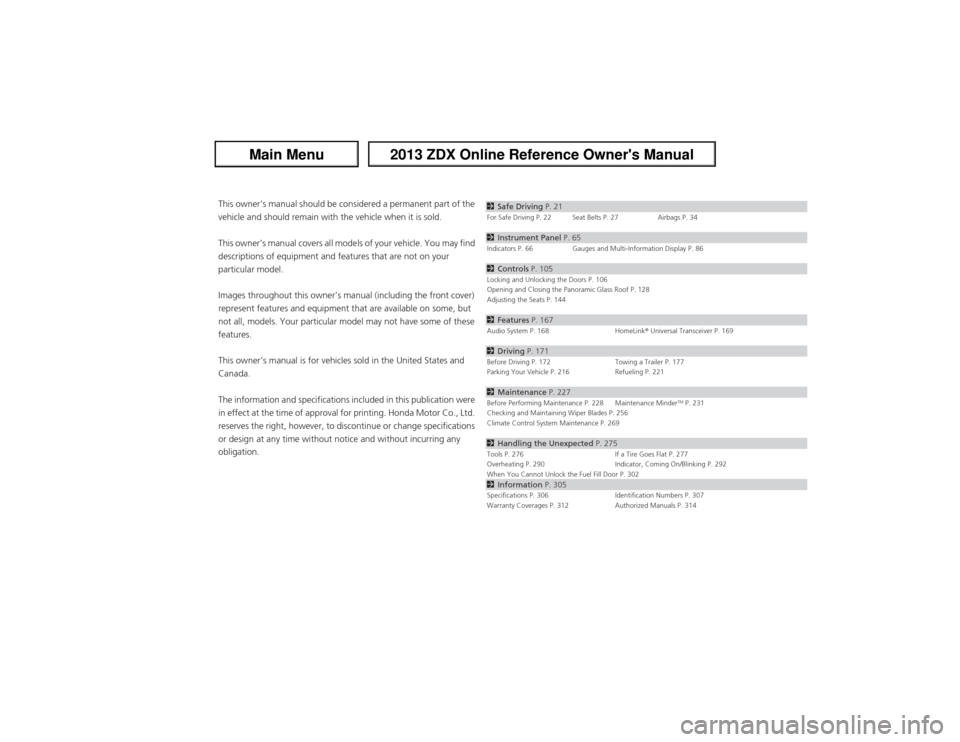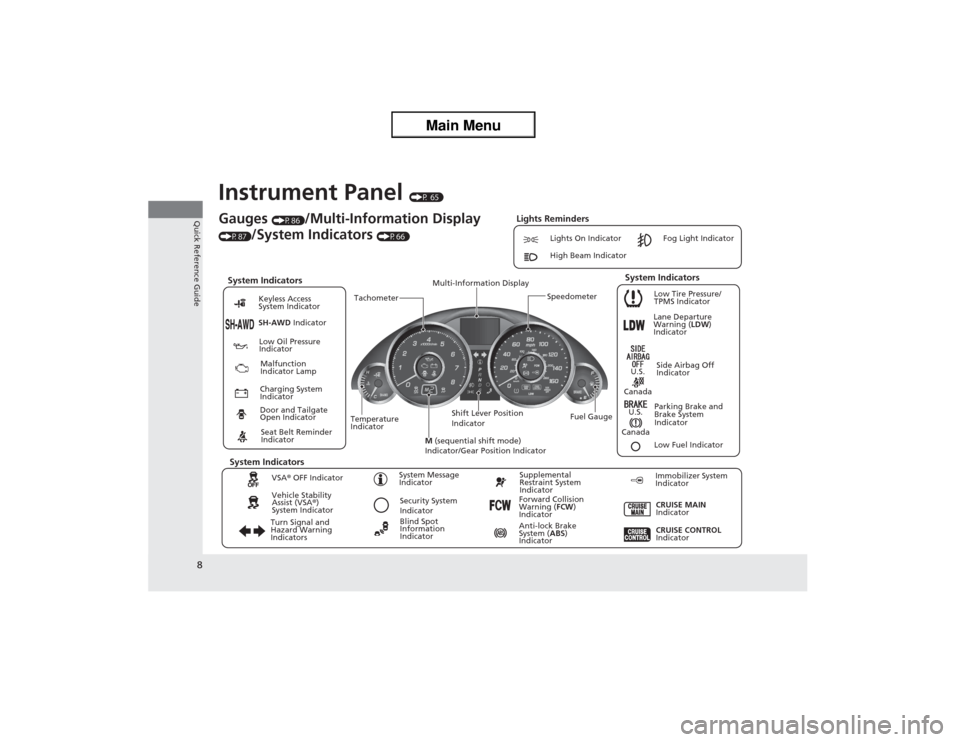2013 Acura ZDX belt
[x] Cancel search: beltPage 1 of 324

ContentsThis owner’s manual should be considered a permanent part of the
vehicle and should remain with the vehicle when it is sold.
This owner’s manual covers all models of your vehicle. You may find
descriptions of equipment and features that are not on your
particular model.
Images throughout this owner’s manual (including the front cover)
represent features and equipment that are available on some, but
not all, models. Your particular model may not have some of these
features.
This owner’s manual is for vehicles sold in the United States and
Canada.
The information and specifications included in this publication were
in effect at the time of approval for printing. Honda Motor Co., Ltd.
reserves the right, however, to discontinue or change specifications
or design at any time without notice and without incurring any
obligation.
2Safe Driving P. 21For Safe Driving P. 22 Seat Belts P. 27 Airbags P. 342Instrument Panel P. 65Indicators P. 66 Gauges and Multi-Information Display P. 862Controls P. 105Locking and Unlocking the Doors P. 106
Opening and Closing the Panoramic Glass Roof P. 128
Adjusting the Seats P. 1442Features P. 167Audio System P. 168 HomeLink® Universal Transceiver P. 1692Driving P. 171Before Driving P. 172 Towing a Trailer P. 177
Parking Your Vehicle P. 216 Refueling P. 2212Maintenance P. 227Before Performing Maintenance P. 228 Maintenance Minder
TM P. 231
Checking and Maintaining Wiper Blades P. 256
Climate Control System Maintenance P. 269
2Handling the Unexpected P. 275Tools P. 276 If a Tire Goes Flat P. 277
Overheating P. 290 Indicator, Coming On/Blinking P. 292
When You Cannot Unlock the Fuel Fill Door P. 3022Information P. 305Specifications P. 306 Identification Numbers P. 307
Warranty Coverages P. 312 Authorized Manuals P. 314
Page 6 of 324

5Quick Reference Guide
❙Grab Handle❙Coat Hook
(P159)
❙Side Curtain Airbags
(P44)
❙Front Seat
(P144)
❙Sunglasses Holder
(P160)
❙Sun Visors❙USB Adapter Cable () See the Navigation Manual❙Auxiliary Input Jack () See the Navigation Manual❙Rear Seat
(P150)
❙LATCH to Secure a Child Seat
(P54)
❙Accessory Power Sockets
(P158)
❙Seat Belts
(P27)
❙Vanity Mirrors❙Side Airbags
(P41)
❙Rear Seat Heater Switches
* (P162)
❙Seat Belt (Installing a Child Seat)
(P57)
❙Seat Belt to Secure a Child Seat
(P59)
* Not available on all models
Page 8 of 324

7Quick Reference Guide
Safe Driving
(P 21)
Airbags
(P34)
●Your vehicle is fitted with airbags to help protect you and
your passengers during a moderate-to-severe collision.
Child Safety
(P49)
●All children 12 and younger should be seated in the rear seat.
●Smaller children should be properly restrained in a forward-facing child seat.
●Infants must be properly restrained in a rear-facing child seat.
Exhaust Gas Hazard
(P63)
●Your vehicle emits dangerous exhaust gases that contain carbon
monoxide. Do not run the engine in confined spaces where carbon
monoxide gas can accumulate.
Before Driving Checklist
(P26)
●Before driving, check that the front seats, head restraints,
steering wheel, and mirrors have been properly adjusted.
Seat Belts
(P27)
●Fasten your seat belt and sit upright well
back in the seat.
●Check that your passengers are wearing
their seat belts correctly.
Fasten your lap belt as
low as possible.
Page 9 of 324

8Quick Reference Guide
Instrument Panel
(P 65)
Lane Departure
Warning (LDW)
Indicator
System Indicators
Malfunction
Indicator Lamp Low Oil Pressure
Indicator
Charging System
Indicator
Anti-lock Brake
System (ABS)
Indicator Vehicle Stability
Assist (VSA®)
System Indicator VSA® OFF IndicatorLow Tire Pressure/
TPMS Indicator
Lights Reminders
Lights On Indicator
High Beam IndicatorFog Light Indicator
Immobilizer System
Indicator Seat Belt Reminder
Indicator
System Indicators
CRUISE CONTROL
Indicator System Message
IndicatorParking Brake and
Brake System
Indicator
Supplemental
Restraint System
IndicatorSide Airbag Off
Indicator
Door and Tailgate
Open Indicator
CRUISE MAIN
Indicator TachometerSpeedometer
Fuel Gauge
Security System
IndicatorShift Lever Position
Indicator
Low Fuel Indicator
Gauges
(P86)
/Multi-Information Display
(P87)
/System Indicators
(P66)
Turn Signal and
Hazard Warning
IndicatorsTemperature
Indicator SH-AWD Indicator Keyless Access
System Indicator
Blind Spot
Information
Indicator
System Indicators
Multi-Information Display
U.S.
CanadaCanada
U.S.
Forward Collision
Warning (FCW)
Indicator
M (sequential shift mode)
Indicator/Gear Position Indicator
Page 18 of 324

17Quick Reference Guide
Why do the doors lock
after I unlocked the doors
using a remote
transmitter?
If you do not open the doors within 30 seconds, the doors are
relocked automatically for security.
Why does the beeper
sound when I open the
driver’s door?
The beeper sounds when:●The exterior lights are left on.●The power mode is in ACCESSORY.
Why does the beeper
sound when I start driving?
The beeper sounds when:●Driver and/or front passenger are not wearing their seat belts.●The parking brake lever is not fully released.
Why do I hear a screeching
sound when I apply the
brake pedal?
The brake pads may need to be replaced. Have your vehicle
inspected by a dealer.
Is it possible to use
unleaded gasoline with a
Pump Octane Number
(PON) of 87 or higher on
this vehicle?
Unleaded gasoline with a pump octane number of 91 or higher
is recommended.
Use of lower octane gasoline can cause occasional metallic
knocking noise in the engine and will result in decreased engine
performance.
Use of gasoline with a pump octane less than 87 can lead to
engine damage.
Page 19 of 324

18Quick Reference Guide
California Proposition 65 WarningEvent Data RecordersThis vehicle is equipped with an event data recorder (EDR).
The main purpose of an EDR is to record, in certain crash or near
crash-like situations, such as an air bag deployment or hitting a
road obstacle, data that will assist in understanding how a vehicle’s
systems performed. The EDR is designed to record data related
to vehicle dynamics and safety systems for a short period of
time, typically 30 seconds or less. The EDR in this vehicle is
designed to record such data as:
•How various systems in your vehicle were operating;
•Whether or not the driver and passenger safety belts were
buckled/fastened;
•How far (if at all) the driver was depressing the accelerator
and/or brake pedal; and,
•How fast the vehicle was traveling.
These data can help provide a better understanding of the
circumstances in which crashes and injuries occur. NOTE: EDR data
are recorded by your vehicle only if a non-trivial crash situation
occurs; no data are recorded by the EDR under normal driving
conditions and no personal data (e.g., name, gender, age, and
crash location) are recorded. However, other parties, such as law
enforcement, could combine the EDR data with the type of
personally identifying data routinely acquired during a crash
investigation.WARNING: This product contains or emits
chemicals known to the state of California to cause
cancer and birth defects or other reproductive
harm.
To read data recorded by an EDR, special equipment is required,
and access to the vehicle or the EDR is needed. In addition to the
vehicle manufacturer, other parties, such as law enforcement, that
have the special equipment, can read the information if they have
access to the vehicle or the EDR.
The data belongs to the vehicle owner and may not be accessed by
anyone else except as legally required or with the permission of the
vehicle owner.Service Diagnostic RecordersThis vehicle is equipped with service-related devices that record
information about powertrain performance. The data can be used
to verify emissions law requirements and/or help technicians
diagnose and solve service problems. It may also be combined with
data from other sources for research purposes, but it remains
confidential.California Perchlorate Contamination Prevention ActThe airbags, seat belt tensioners, and CR type batteries in this
vehicle may contain perchlorate materials - special handling may
apply. See www.dtsc.ca.gov/hazardouswaste/perchlorate/
As you read this manual, you will find information that is preceded
by a symbol. This information is intended to help you avoid
damage to your vehicle, other property, or the environment.
NOTICE
Page 22 of 324

21
Safe Driving
You can find many safety recommendations throughout this chapter, and throughout this manual.
For Safe Driving
Important Safety Precautions ............. 22
Important Handling Information......... 24
Your Vehicle’s Safety Features............ 25
Seat Belts
About Your Seat Belts ........................ 27
Fastening a Seat Belt .......................... 30
Seat Belt Inspection............................ 33
Airbags
Airbag System Components ............... 34
Types of Airbags ................................ 37
Front Airbags (SRS) ............................ 37Side Airbags ...................................... 41
Side Curtain Airbags .......................... 44
Airbag System Indicators.................... 45
Airbag Care ....................................... 48
Child Safety
Protecting Child Passengers ............... 49
Safety of Infants and Small Children ....... 51Safety of Larger Children ................... 61
Exhaust Gas Hazard
Carbon Monoxide Gas ....................... 63
Safety Labels
Label Locations .................................. 64
Page 23 of 324

22Safe Driving
For Safe DrivingThe following pages explain your vehicle’s safety features and how to use them
properly. The safety precautions below are ones that we consider to be among the
most important.Important Safety Precautions■Always wear your seat belt
A seat belt is your best protection in all types of collisions. Airbags are designed to
supplement seat belts, not replace them. So even though your vehicle is equipped
with airbags, make sure you and your passengers always wear your seat belts, and
wear them properly.■Restrain all children
Children age 12 and under should ride properly restrained in a back seat, not the
front seat. Infants and small children should be restrained in a child seat. Larger
children should use a booster seat and a lap/shoulder seat belt until they can use the
belt properly without a booster seat.■Be aware of airbag hazards
While airbags can save lives, they can cause serious or fatal injuries to occupants
who sit too close to them, or are not properly restrained. Infants, young children,
and short adults are at the greatest risk. Be sure to follow all instructions and
warnings in this manual.■Don’t drink and drive
Alcohol and driving don’t mix. Even one drink can reduce your ability to respond to
changing conditions, and your reaction time gets worse with every additional drink.
So don't drink and drive, and don't let your friends drink and drive, either.
1Important Safety Precautions
Some states, provinces and territories prohibit the use
of cell phones other than hands-free devices by the
driver while driving.